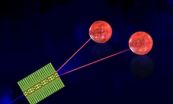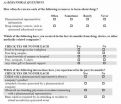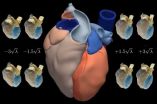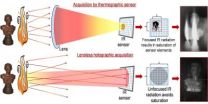(Press-News.org) EAST LANSING, Mich. — Fat worms confirm that researchers from Michigan State University have successfully engineered a plant with oily leaves -- a feat that could enhance biofuel production as well as lead to improved animal feeds.
The results, published in the current issue of The Plant Cell, the journal of the American Society of Plant Biologists, show that researchers could use an algae gene involved in oil production to engineer a plant that stores lipids or vegetable oil in its leaves – an uncommon occurrence for most plants.
Traditional biofuel research has focused on improving the oil content of seeds. One reason for this focus is because oil production in seeds occurs naturally. Little research, however, has been done to examine the oil production of leaves and stems, as plants don't typically store lipids in these tissues.
Christoph Benning, MSU professor of biochemistry and molecular biology, led a collaborative effort with colleagues from the Great Lakes Bioenergy Research Center. The team's efforts resulted in a significant early step toward producing better plants for biofuels.
"Many researchers are trying to enhance plants' energy density, and this is another way of approaching it," Benning said. "It's a proof-of-concept that could be used to boost plants' oil production for biofuel use as well as improve the nutrition levels of animal feed."
Benning and his colleagues began by identifying five genes from one-celled green algae. From the five, they identified one that, when inserted into Arabidopsis thaliana, successfully boosted oil levels in the plant's leaf tissue.
To confirm that the improved plants were more nutritious and contained more energy, the research team fed them to caterpillar larvae. The larvae that were fed oily leaves from the enhanced plants gained more weight than worms that ate regular leaves.
For the next phase of the research, Benning and his colleagues will work to enhance oil production in grasses and algae that have economic value. The benefits of this research are worth pursuing, Benning said.
"If oil can be extracted from leaves, stems and seeds, the potential energy capacity of plants may double," he said. "Further, if algae can be engineered to continuously produce high levels of oil, rather than only when they are under stress, they can become a viable alternative to traditional agricultural crops."
Moreover, algae can be grown on poor agricultural land – a big plus in the food vs. fuel debate, he added.
"These basic research findings are significant in advancing the engineering of oil-producing plants," said Kenneth Keegstra, GLBRC scientific director and MSU University Distinguished Professor of biochemistry and molecular biology. "They will help write a new chapter on the development of production schemes that will enhance the quantity, quality and profitability of both traditional and nontraditional crops."
###
Additional MSU researchers and GLBRC members contributing to the study include Gregg Howe, biochemistry and molecular biology professor; John Olhrogge, University Distinguished Professor of plant biology; and Gavin Reid, biochemistry and molecular biology associate professor.
Michigan State University has been working to advance the common good in uncommon ways for more than 150 years. One of the top research universities in the world, MSU focuses its vast resources on creating solutions to some of the world's most pressing challenges, while providing life-changing opportunities to a diverse and inclusive academic community through more than 200 programs of study in 17 degree-granting colleges.
For MSU news on the Web, go to MSUToday. Follow MSU News on Twitter at twitter.com/MSUnews.
'Fat worms' inch scientists toward better biofuel production
2013-02-26
ELSE PRESS RELEASES FROM THIS DATE:
Clever battery completes stretchable electronics package
2013-02-26
Northwestern University's Yonggang Huang and the University of Illinois' John A. Rogers are the first to demonstrate a stretchable lithium-ion battery -- a flexible device capable of powering their innovative stretchable electronics.
No longer needing to be connected by a cord to an electrical outlet, the stretchable electronic devices now could be used anywhere, including inside the human body. The implantable electronics could monitor anything from brain waves to heart activity, succeeding where flat, rigid batteries would fail.
Huang and Rogers have demonstrated ...
Cleveland Clinic study shows bariatric surgery restores pancreatic function by targeting belly fat
2013-02-26
In a substudy of the STAMPEDE trial (Surgical Therapy And Medications Potentially Eradicate Diabetes Efficiently), Cleveland Clinic researchers have found that gastric bypass surgery reverses diabetes by uniquely restoring pancreatic function in moderately obese patients with uncontrolled type 2 diabetes.
The two-year substudy evaluated the effects of bariatric surgery and intensive medical therapy on blood sugar levels, body composition, and pancreatic beta-cell function. Striking metabolic changes were observed in patients who underwent bariatric surgery compared with ...
Light particles illuminate the vacuum
2013-02-26
The researchers conducted a mirror experiment to show that by changing the position of the mirror in a vacuum, virtual particles can be transformed into real photons that can be experimentally observed. In a vacuum, there is energy and noise, the existence of which follows the uncertainty principle in quantum mechanics.
If we act fast enough, we can prevent the particles from recombining – they will then be transformed into real particles that can be detected', says Dr. Sorin Paraoanu from Aalto University.
For the experiment, the researchers used an array of superconducting ...
Target: Cancer
2013-02-26
For scientists to improve cancer treatments with targeted therapeutic drugs, they need to be able to see proteins prevalent in the cancer cells. This has been impossible, until now. Thanks to a new microscopy technique, University of Akron researcher Dr. Adam Smith, assistant professor of chemistry, has observed how clusters of epidermal growth factor receptor (EGFR) — a protein abundant in lung and colon cancers, glioblastoma and others — malfunctions in cancer cells.
"We can directly observe protein clusters, in a living cell membrane, that are invisible to traditional ...
Superbugs may have a soft spot, after all
2013-02-26
The overuse of antibiotics has created strains of bacteria resistant to medication, making the diseases they cause difficult to treat, or even deadly. But now a research team at the University of Rochester has identified a weakness in at least one superbug that scientists may be able to medically exploit.
Biologists Gloria Culver at Rochester and Keith Connolly, now at Harvard University, thought one key to stopping the bacteria may lie with proteins, so they studied the mechanism behind the development of bacterial ribosomes—the cell's protein-manufacturing machine. ...
Gut microbiota plays important role in functional bowel disorders
2013-02-26
(24 February 2013) An estimated 50 per cent of patients consulting a gastroenterologist suffer from functional bowel disorders (FBD), such as dyspepsia or irritable bowel syndrome (IBS). It is characteristic for these conditions that underlying physiological mechanisms are hard to be found. "However, recent research shows that the gut microbiota is a likely candidate for filling some of the gaps in the causal chain leading to FBD," says Professor Fernando Azpiroz, Chairman of the Gut Microbiota & Health Section of the European Society of Neurogastroenterology & Motility ...
Fecal microbiota transplantation cures gastrointestinal diseases
2013-02-26
(26 February 2013) Clostridium difficile infections have developed into a virtual pandemic over the past two decades. The outcome of standard antibiotic treatment is unsatisfactory: the recurrence rates are high with every relapse increasing the risk of further follow-ups. Faecal microbiota transplantation offers a rapidly acting and highly effective alternative in treating recurrent Clostridium difficile infections (RCDI), as Professor Lawrence J. Brandt (Montefiore Medical Center, New York, USA) points out. According to him, more than 90 per cent of the patients are being ...
Survey shows medical students have frequent interactions with pharmaceutical companies
2013-02-26
Boston – A first-of-its kind national survey of medical students and residents finds that despite recent efforts by medical schools and academic medical centers to restrict access of pharmaceutical sales representatives to medical trainees, medical students and residents still commonly receive meals, gifts, and industry-sponsored educational materials. The study was completed by a team of researchers led by fourth-year Harvard Medical School student Kirsten Austad and Aaron Kesselheim, M.D., J.D., M.P.H., an internist and health policy researcher in the Division of Pharmacoepidemiology ...
An atlas of the human heart is drawn using statistics
2013-02-26
Researchers at Pompeu Fabra University (Spain) have created a high resolution atlas of the heart with 3D images taken from 138 people. The study demonstrates that an average image of an organ along with its variations can be obtained for the purposes of comparing individual cases and differentiating healthy forms from pathologies.
"This atlas is a statistical description of how the heart and its components – such as the ventricles and the atrium – look," as explained to SINC by Corné Hoogendoorn, researcher at the CISTIB centre of the Pompeu Fabra University.
Scientists ...
Infrared digital holography allows firefighters to see through flames, image moving people
2013-02-26
Firefighters put their lives on the line in some of the most dangerous conditions on Earth. One of their greatest challenges, however, is seeing through thick veils of smoke and walls of flame to find people in need of rescue. A team of Italian researchers has developed a new imaging technique that uses infrared (IR) digital holography to peer through chaotic conflagrations and capture potentially lifesaving and otherwise hidden details. The team describes its breakthrough results and their applications in a paper published today in the Optical Society's (OSA) open-access ...



